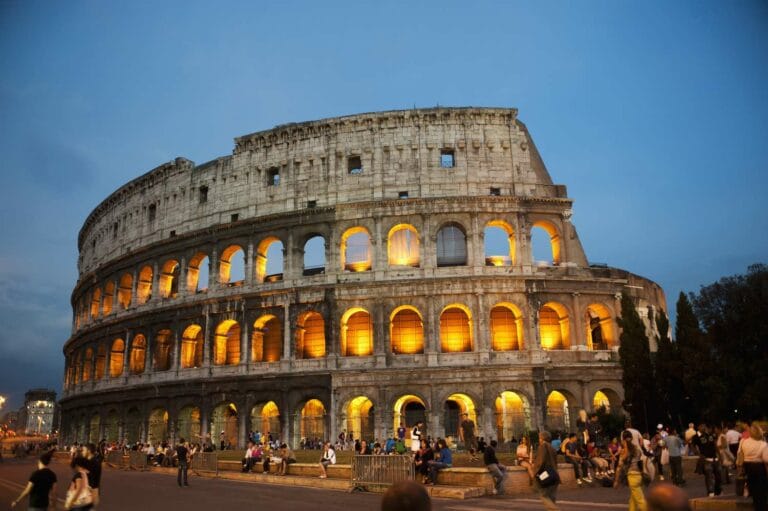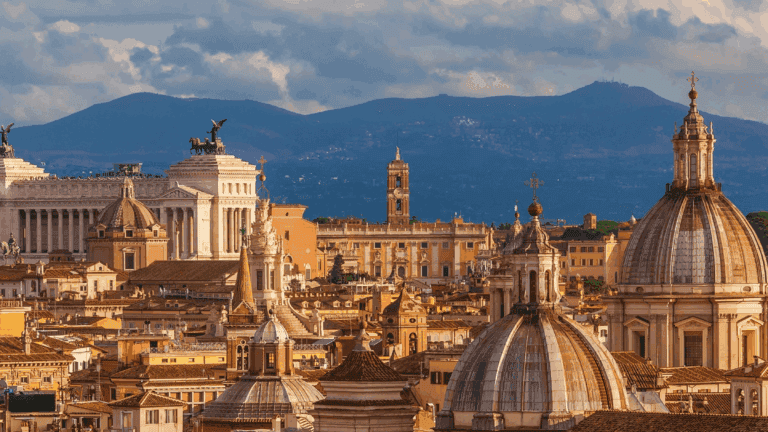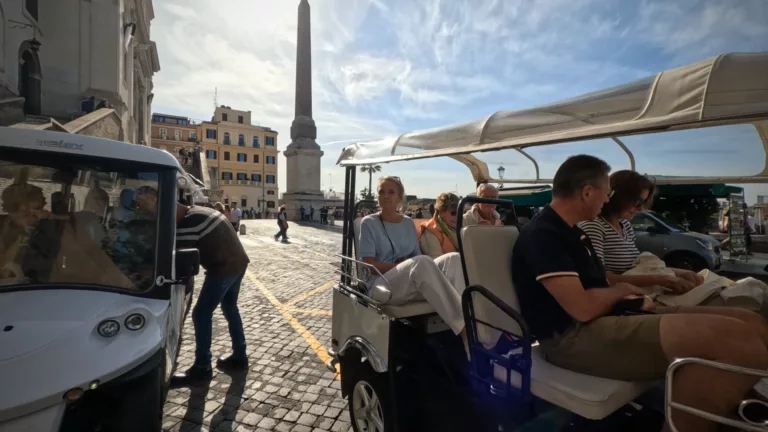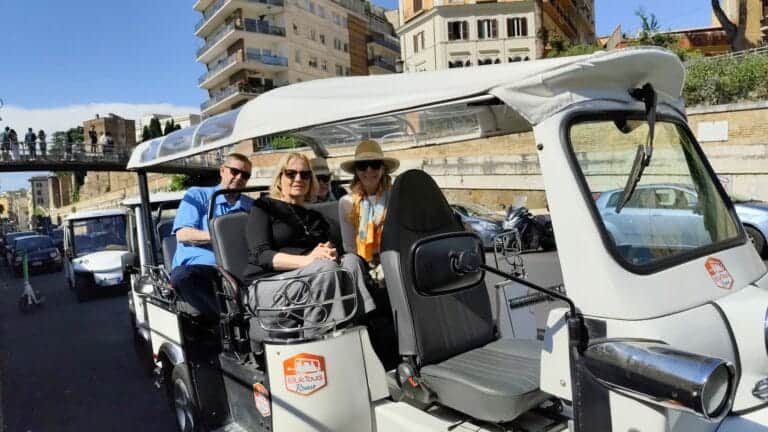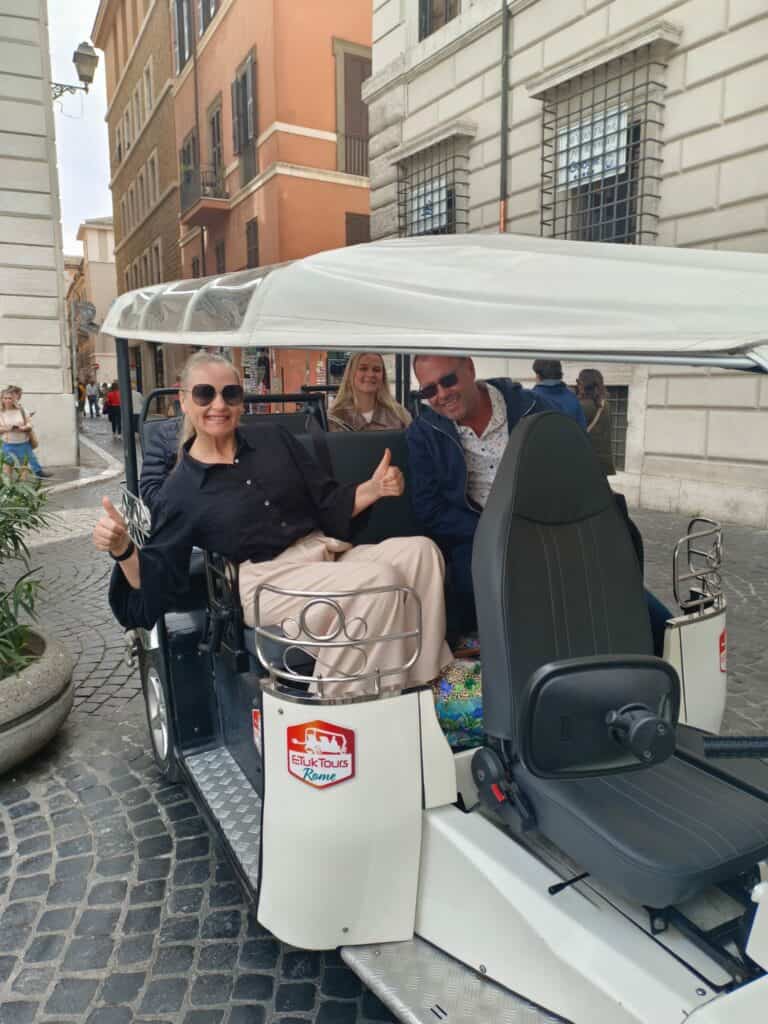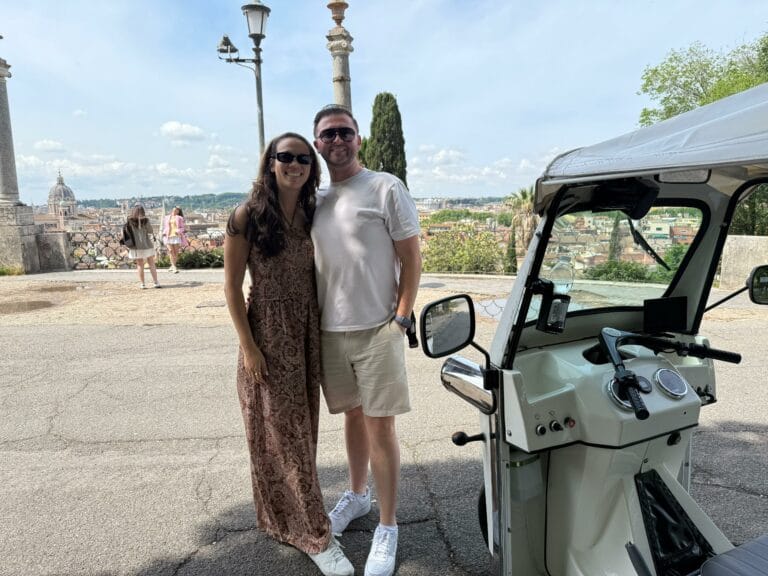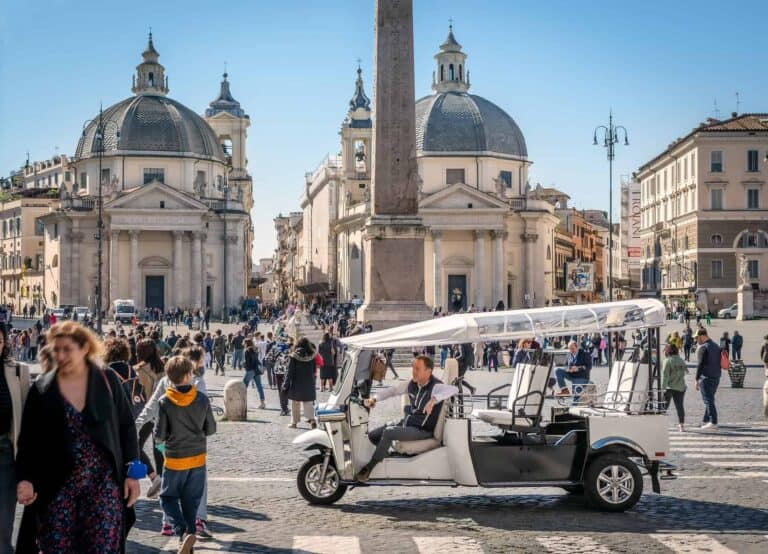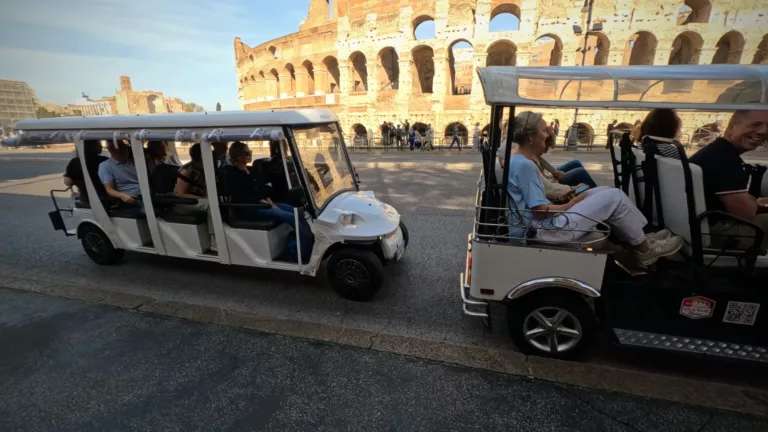Rome Evening Tour by Golf Cart
What type of tour is this?
PrivateHow long is the duration of the tour?
2 HourHow long is the tour in kilometers?
15 km
Experience the magic of Rome by night on our 2-hour Evening Tour of Rome by Golf Cart.
Our expert driver guide takes you to two of the most breathtaking spots overlooking the cityscape: Passegiata del Pincho and the Garibaldi Monument.
Description
Witness the city’s iconic landmarks bathed in the soft glow of twilight as you wander through its historic streets. Let the bustling energy of the city by day transform into a peaceful elegance by night. Don’t miss this opportunity to see Rome in a whole new light.
Enjoy the city’s most breathtaking spots with stunning views overlooking the city from up high—the Passegiata del Pincho and the Garibaldi Monument.
Book our unforgettable evening tour of Rome by Golf Cart now and create magical memories that will last a lifetime.
Meeting Point
What's included?
- Private transportation
What's not included?
- Food & drinks
- Snacks
What to bring?
- Weather-appropriate clothing
Not Suitable For?
What to know before you go:
- Not wheelchair accessible
- Not stroller accessible
- Not suitable for pets
- Infants must not sit on laps
- Infant seats unavailable
Cancelation Policy
- Refund if cancelled at least 3 days before the event
Itinerary Route
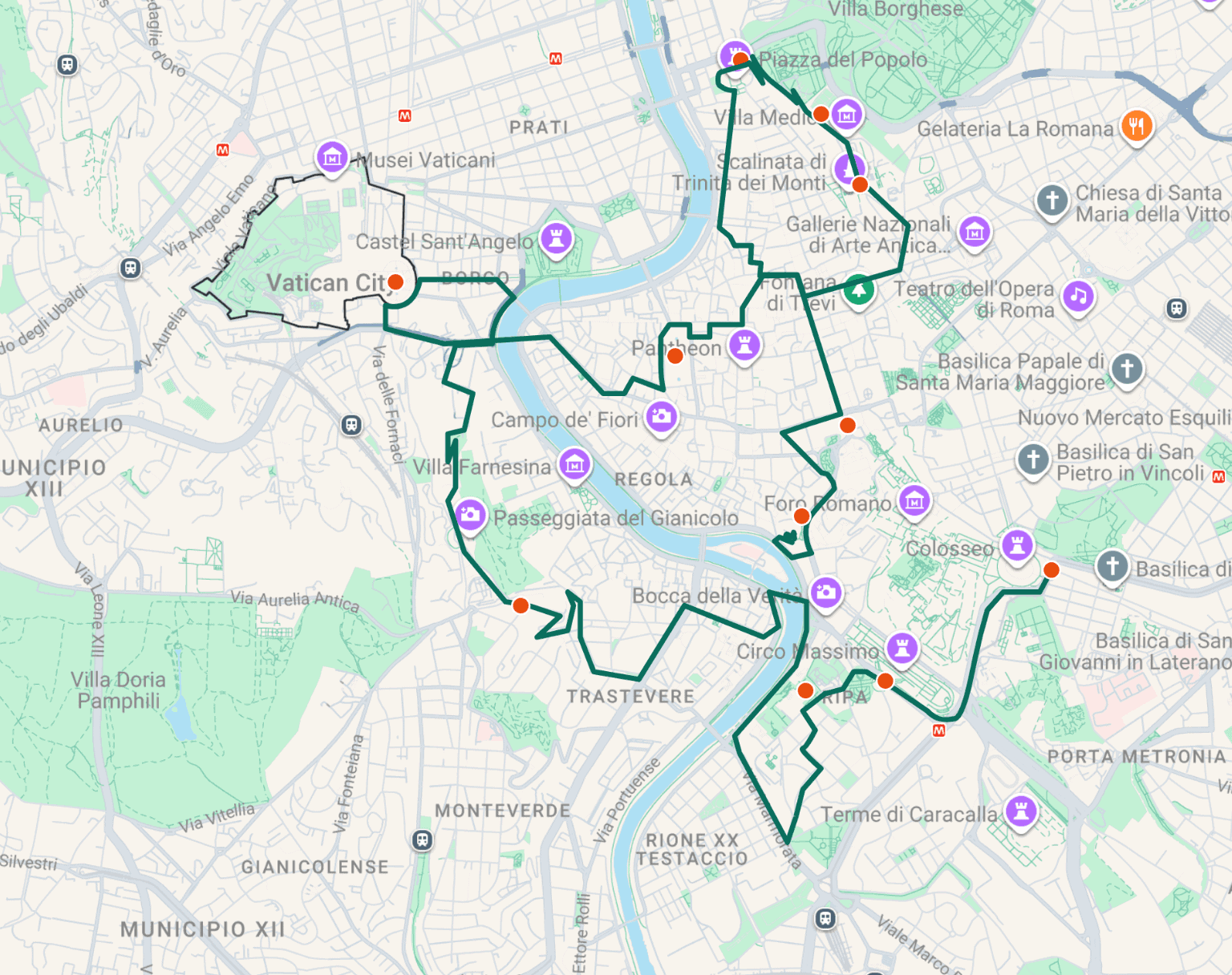
The Colosseum / Flavian Amphitheatre
The Colosseum’s original name is the Flavian Amphitheatre. Maybe the most famous monument in the world. Built between 70 AD and 80 AD to host the gladiator games. It fitted 50.000 spectators. The Colosseum was covered in marble and statues. It has been in use until 438 AD for almost 400 years. The name Colosseum derives from the gigantic golden statue that Nero had placed right even before the Colosseum existed. This statue was 30 meters tall and called a ‘colossus’. The amphitheater took on the name of the statue.
The Circus Maximus
The Circus Maximus is considered the largest stadium ever built. At the time of Trajan, it could host over 200.000 spectators. It was already used in the Republic (400 BC) for the chariot races. It was Julius Caesar that started the creation of walls around the circus. The large field is about 600 meters long and 140 meters wide. From where we will stop you can admire the circus and also the Palatine hill. Today, the field is still used for recreational purposes and hosts many concerts and festivals.
The Orange Garden/Aventine Hill
The Orange Garden is one of the most romantic spots in Rome. Located right next to the ancient basilica of Santa Sabina, the gardens offer a nice spot to relax on w warm day, but they also offer one of the best panoramic views over Rome from its large balcony. We look out through the Roman pine trees on the Saint Peters Dome. A quick visit to the Santa Sabina basilica is a must with its original wooden door dating back to the early 5th century.
Bocca della Verità / Mouth of Truth
The Bocca della Verità can be recognized by the long waiting lines with people who want to get a photo of their hand placed in a round-shaped stone’s big mouth. The legend of the Mouth of Truth dates back to 1485 and tells that the mouth of the stone could eat your hand if you did not tell the truth, therefore ‘mouth of truth’. The stone was placed at the Santa Maria in Cosmedin church entrance in 1632. The stone was most likely used in Roman times as the cover of a water well. The stone became World famous due to the film ‘Vacanze Romane’ (Roman Holiday) with Gregory Peck and Audrey Hepburn.
The Fontanone or Mostra dell’acqua Paola)
The Fontanone is what the Romans call this magnificent fountain meaning ‘the big fountain’. Commissioned by Pope Paolo V, a Borghese Pope. This fountain was the end point of the Trajan-Paolo aqueduct that was destroyed and Pope Paul the V took on the job to restore this water source to provide the lower Trastevere district with drinking water. This gesture made him very popular.
Piazza Garibaldi
Garibaldi Square is considered the best place to admire the eternal city. Below the balcony, you can see the botanical garden, and you look out over Trastevere, the historic center, on a clear day. You can admire the Apennine mountain range, which can be covered with snow in winter.
The Spanish Steps / Trinità dei Monti
The Spanish Steps were built between 1723 and 1726 by Francesco de Sanctis to connect the upper Pincio hill with the Piazza di Spagna. The name derives from the Spanish Embassy down the steps on the square. For many years, the steps were a place where people would gather and sit, serving as a famous meeting point. It has lost that function, but it is always an elegant place to enter glamorous shopping streets like Via Condotti. On top of the steps, we find the Santissima Trinità dei Monti church, founded by Francesco de Paola in 1494. You have a great view over Rome and the Vatican City from where the obelisk stands.
Villa Borghese
The Villa Borghese Park covers a large area not far from the city center. The park belonged to the powerful Borghese family, and the villa (mansion) was built in 1633 to host the extensive collection of art from the Borghese family. The Italian state bought the park in 1903, and the villa is now one of the finest museums in Rome. The end of the park above Piazza del Popolo, the so-called Pincio, offers unique views over the square and the Vatican City. The sunsets are breathtaking here.
Piazza del Popolo
We stop near the magnificent entrance gate now called the porta del Popolo and formerly known as the Porta Flaminia). We can admire the ellipse shaped square with in the center one of the best preserved obelisks of Rome. It was the first obelisk brought to Rome by Augustus. From the piazza three straight roads lead into town, we call this the tridente (trident): via del Babuino, via del Corso and via di Ripetta. For art lovers we suggest to have a glimpse insight the Santa Maria del Popolo where one can admire 2 paintings of Caravaggio. The piazza del Popolo is still one of the liveliest squares of Rome.
Piazza Venezia / Venice Square
Venice Square is Rome’s busiest and most chaotic square, but there is a lot to admire. We will show you the entrance steps towards Capital Hill, with the Basilica of Santa Maria in Aracoeli right next to it, dating back to the 6th century AD. The entrance has a Roman Gothic appearance. Below the basilica, we will find the ruins of a Roman Insula dating back to the 2nd century AD. We will pass in front of the Vittoriano, a massive monument seen from all the hills of Rome. Built in honor of King Vittorio Emanuele II, it finished in 1911. It is for sure the most discussed building in Rome.
Teatro di Marcello
Julius Caesar started the Theatre of Marcellus, but he was murdered, and Augustus finished it in 17 BC. He named it after his nephew Marcellus, who died young of illness. The theatre had a capacity of 15.000 seats and was operational until the 4th century. The Savelli family built houses on top of it, and later, they were bought by the Orsini family, who still owns them.
Family Owned
Locally Owned
Sustainable Tourism
See all our Rome Golf Cart Tours

